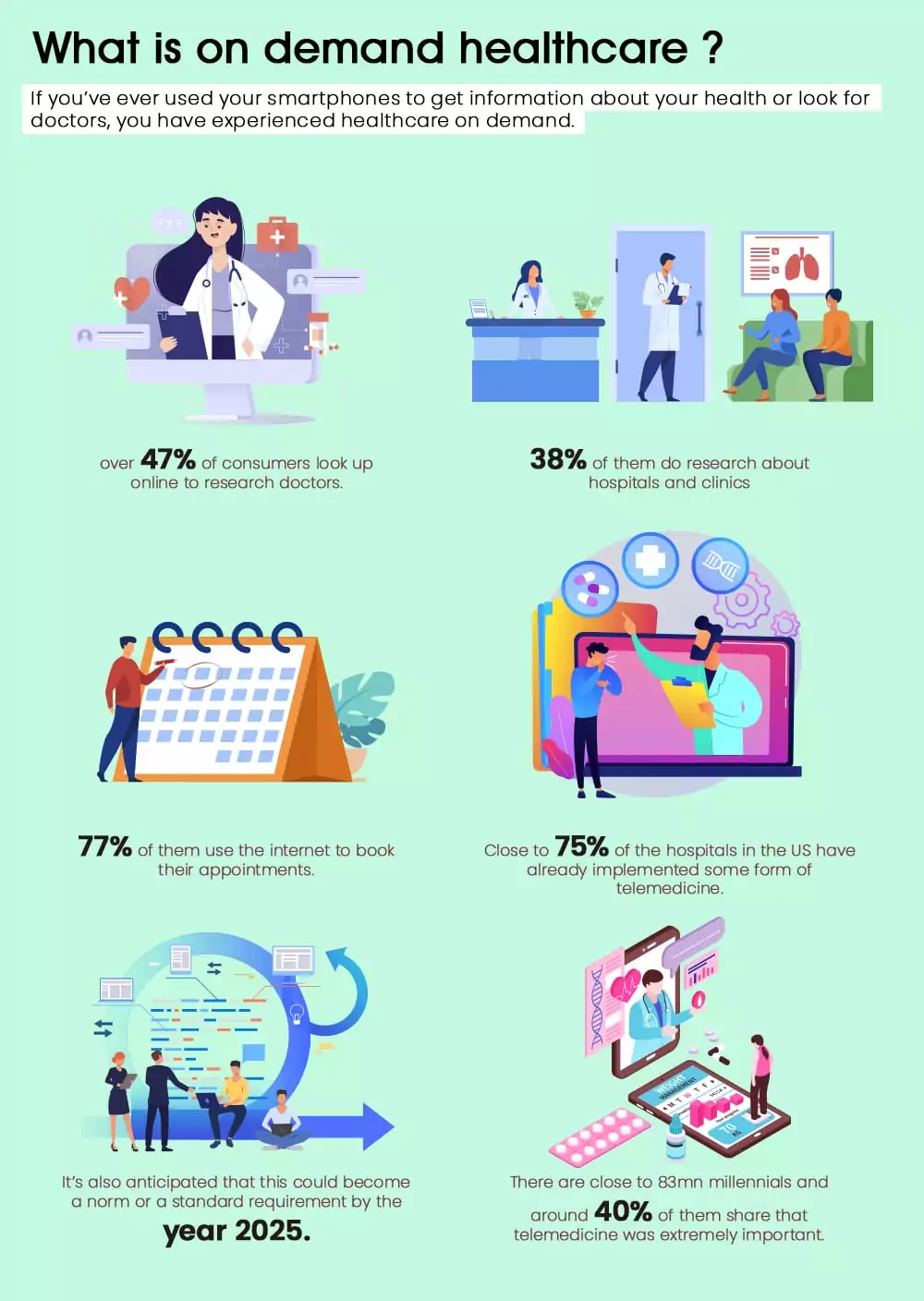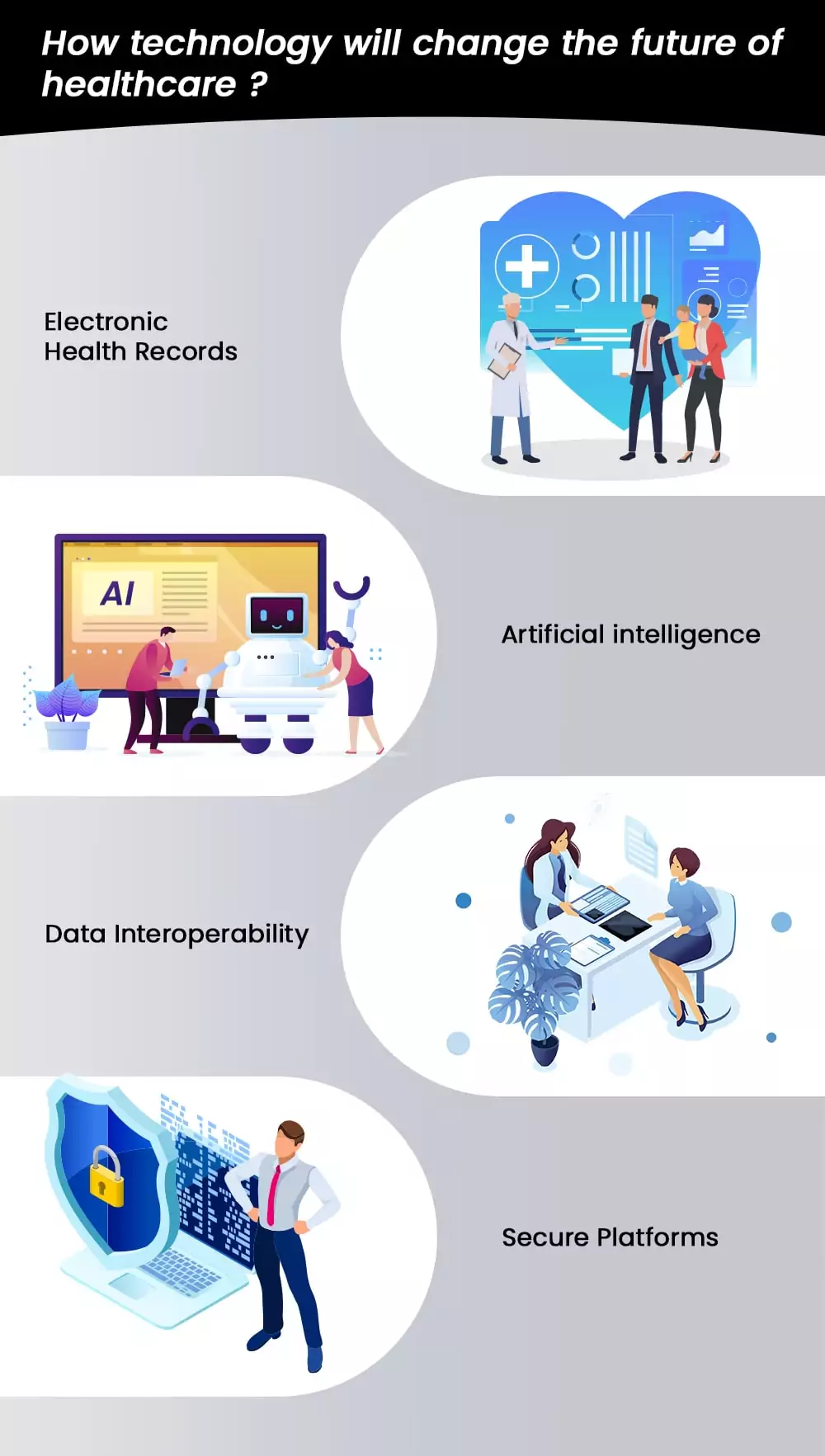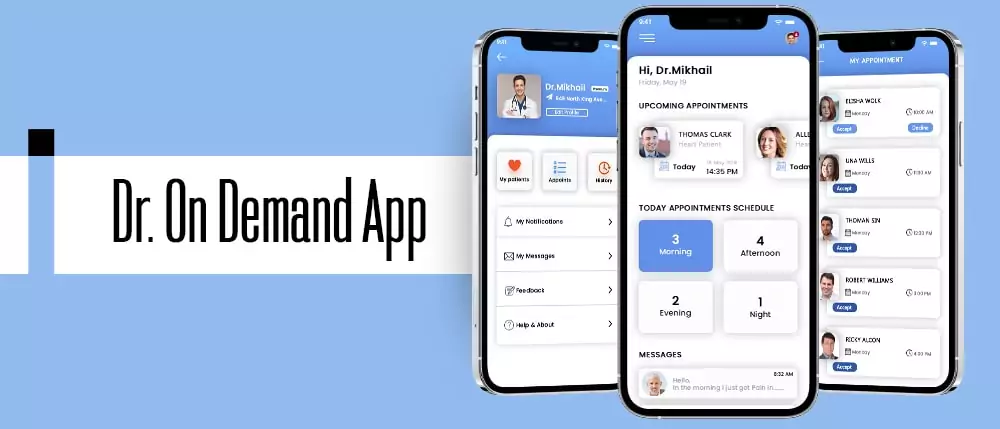There was a time when conventions defined the way things worked. There were generic models of operations, revenue generation and service delivery in place and consumer experiences were uniform, linear and mostly unanimous.
But cut to a decade back, things gradually started changing. Disruptive technologies made their way into the market and rewrote conventions. Today, our way of accessing information, services and buying products have dramatically changed.
And this is exactly what we are about to discuss in today's post.
Hello and welcome to another post on the Digital Transformation in Healthcare series. In our last post, we extensively covered what digital health is and its complete broken-down explanation of its components.
In this post, we will explore the newest development in healthcare – on-demand healthcare.
The World of On Demand Healthcare
The term on-demand has become household with everyone being familiar with what it does and how it works. Well, at least at the basic level.
What is on demand healthcare?
If you’ve ever used your smartphones to get information about your health or look for doctors, you have experienced healthcare on demand. This is a remarkable milestone in our timeline as this shows us drifting dynamically away from generic healthcare options available to us and following linear ways of approaching healthcare.

Today, we could demand healthcare services such as health insurance policies, diagnosis, treatments and even specialist surgeons on demand for our cases. The entire paradigm of operational standards has changed with us – consumers – being at the fulcrum.
While the trend started with changes in other industries such as entertainment (Netflix), transportation (Uber), accommodation and hospitality (AirBnB and Booking.com), shopping (Amazon) and more, the wave was gradual in healthcare mainly because of the ample regulations, complexities and sizes involved.
Yet, we have evolved into something that is very different from how healthcare was a decade back.
For those of you who didn’t know, over 47% of consumers look up online to research doctors. 38% of them do research about hospitals and clinics and 77% of them use the internet to book their appointments.
It’s not just the mindset of consumers that is changing with evolving technologies. Healthcare providers are required to be a step ahead to anticipate consumer behavioural changes and accommodate them as well. That’s why close to 75% of the hospitals in the US have already implemented some form of telemedicine. It’s also anticipated that this could become a norm or a standard requirement by the year 2025.
As millennials continue to join workforces and gain important aspects of the society, they demand on-demand services as benchmarks. There are close to 83mn millennials and around 40% of them share that telemedicine was extremely important.
If the trend continues (which we are sure it will), we could only witness the healthcare sector completely doing away with fragmented and location-bound centers to more virtual and personal models with relative decrease in healthcare expenses.
What will healthcare look like in 2030?
This transformation is anticipated to reduce healthcare expenses by 60%.
Take the pharmaceutical sector for instance. If you notice its current continuum, there are 6 entities operating between drug or medication manufacturers and consumers:
- Wholesale distributors
- Funders
- Brokers
- Payers
- Providers
- And Consumers
But with the on-demand ecosystem, there are just three entities operating:
- Wholesale distributors
- Funders
- And on-demand platforms
This model eliminates the requirement of less resourceful entities from the chain to optimize service delivery, patient care, time and ultimately expenses. So, in five years, healthcare will further go on to become virtualized, personalized and delocalized.
The Birth of New Business Models

To put the facts and ideas we are about to present in perspective, let’s first understand that there are over 3.5bn users who use smartphones in the world today. 77% of the US citizens have smartphones and close to 47% of them reveal that they can’t live without one.
The thing with smartphones is that the experience you have with brands, business and services such as entertainment, shopping and even healthcare is not generic. When you access healthcare or entertainment from your friend’s phone, the results and experiences you would get will be completely different from what you would get on your phone.
So, services are not generic, vague or linear anymore. They are highly personalized. Smartphones have put users first in terms of experiences and have shaped a world where service providers are also pushed to join this cycle.
Regardless of which industry you choose, consumers or users would always be at the center of all decisions and activities today. This phenomenon has given rise to newer business models that are highly centered around consumers. And the immensely successful business model to come out of this is the on-demand economy.
To understand how successful the economy is, let’s look at a few numbers:
- The on-demand economy has over 22.4mn users across the world.
- The spending in this economy is over $57.6bn.
- Over 75% of the funding are bagged by on-demand companies.
- Over 51% of the companies that have adopted on-demand infrastructures have reported profits.
The new business model is just starting to disrupt the healthcare sector with the integration of airtight tools and techniques, concepts, ecosystems and more.
And this is what we are about to discuss in detail next.
The Digitized Healthcare Ecosystem
The healthcare sector has not been the same ever since the onset of disruptive technologies like Artificial Intelligence (AI) & Machine Learning (ML), Deep Learning (DL), Big Data, Internet of Things (IoT) and more.
With 5G technology ready for deployment, we can only anticipate faster delivery of services and optimized connectivity. All these together have given rise to actionable elements that weren’t possible before.
Telemedicine, for instance, was unimaginable until a decade back when smartphones were expensive and the internet had not become a rage. Today, healthcare can be available by anyone from anywhere from the palm of their hands.
And it’s not just the consumers who are waking up to this realization. Several companies and key healthcare organizations from around the world are reinvesting in health IT. Meaning, they are channelizing part of their budget and revenue towards upgrading or developing custom software and enterprise applications to facilitate digital healthcare.
They are rolling out apps to offer better engagement, adopting advanced tech infrastructures, making use of data and analytics to understand their users better and offer personalized health and patient care and more.
Healthcare startups are all across the Valley and other developing nations, addressing one major healthcare issue at a time. Big market players such as Google, Amazon, Microsoft and more are backing these startups or are opening up newer wings to support the booming of digital and on-demand healthcare. This is to such an extent that concepts like telehealth and virtual care are some of the hottest areas that attract major investments. Around $700mn have been raised in these sectors in the first quarter of 2019 alone.
These movements are making healthcare increasingly accessible and taking localized healthcare to an on-demand based globalized healthcare. In this, a patient in a suburb in Brazil can connect with a specialist neurosurgeon from California and get treated for their concerns.
Not just services, the on-demand healthcare ecosystem is also rolling out tangible products in the form of apps to facilitate better healthcare. For instance, diabetic patients can now know in real-time their caloric intake and blood sugar levels with the help of wearable devices. These devices work in tandem with their custom-developed apps and even notify when blood sugar levels would shoot up with the help of predictive analytics.
There are consumer information repositories, on-demand pharmacies, custom-generated health insurance policies and more that are putting consumers first in the chain and delivering personalized services
How technology will change the future of healthcare?
The future we have in our mind for on-demand healthcare is radical and highly organized. The ecosystem will have moved out from being fragmented like it was (and still is majorly) to become more uniform and omni. We are looking at healthcare like we look at banks, airlines and most importantly, fast-food venues.
If you notice, you would get a uniform experience regardless of the branch or location you visit. The counters or the airport don’t matter for your preferred airlines and you are bound to get your burger in a minute regardless of which location of your favourite food joint you are in.
Healthcare would rebrand and re identify itself to join this bandwagon. As of now, the experience you have in clinics and hospitals is very distinct. Each center has its own way of approaching treatment and diagnosis and it’s very difficult when you opt for second opinions or referrals from physicians.
The experiences are scattered and cluttered. But going ahead, it will become completely standardized and efficient. Costs will be uniform throughout and all these will be achieved through digital transformation.

When you talk about digital transformation in on-demand healthcare, you need to understand four different elements:
- Electronic Health Records
- AI
- Data Interoperability
- And Secure Platforms
Like we saw in our previous posts, electronic health records are details of you and your health that rest on the cloud. Data interoperability is where this record is available for instant access and retrieval by any clinician, physician, surgeon or specialists for quick diagnosis and treatment. Platforms are the portals that make this possible.
When you have all these working together, operating standards would be easily set and experiences could not only be optimized but tracked in real-time as well. The best part about this transformation is that the treatments and healthcare provided would still be personalized as they stem from your personal data generated through various touchpoints.
We would also be working along with specialized bots and robots who would be working on executing redundant tasks like checking our vitals, getting invoices and billing done. AI would be taking care of predicting the next heart attack or tumors turning malignant. And doctors and specialists would join in to provide their highly specific services such as surgeries and treatments.
We are gradually getting to a world where one size doesn’t fit all. We are becoming more inclusive and customized.
Managing Healthcare Reinvention
As exciting and effective it sounds, it is equally difficult to achieve. We are right now at the bottom of the graph of healthcare digital revolution and where we intend to reach is a couple of blocks higher.

To get there, solid ideas and the availability of tech are not enough. Investments in huge quantities are required for companies to scale to such levels. Also, it is immensely important for clinics, hospitals and healthcare centers to continue to focus on patientcare amidst such transitions.
So, this transition requires a systematic approach. To understand the basics of it, let’s explore some aspects of the approach.
- Companies could work on areas where they incur redundant expenses and take out costs and do away with them. They could minimize such expenses wherever possible.
- Scale up their IT capabilities by upgrading to latest tech infrastructures, software applications and systems.
- Businesses should come up with newer and modified versions of their pricing that are patient-friendly, personalized and liberative.
- Work on making data more interoperable among stakeholders including insurance companies to fast-track claims.
- Redefine patient experience and bring in humane elements despite the abundance of tech.
- Switch to newer payment models
- Make their operations transparent including their attitude towards patient data and their usage.
- Retrain their talent pool to be comfortable with digital transformation.
- Implement more AI
Case Study
There is no dearth of real-world examples when it comes to on-demand healthcare. The most prominent one we are about to cover is called Doctor On Demand. This healthcare portal is based on the on-demand economy and offers a service that allows physicians, psychiatrists, consultants, psychologists and other specialists to connect virtually with patients over tablets, smartphones and other devices.
By downloading the app or accessing the portal, users can describe their symptoms to the specialists and connect on a virtual consultation session. Doctor On Demand is clearly a leader in the telemedicine space as its positive ratings on app stores (5 stars) are thrice the ratings of similar apps or services in the niche. Also, their statistics claims that 87% of their patients love the services and have turned into evangelists for the brand.
The portal offers four types of services:
- Urgent or emergency care
- Behavioural care for emotional support
- Preventive health
- And chronic care
A few months back, the company also raised a $75mn Series D funding backed by General Atlantic. The funding is being channelled to building virtual primary care practices, where patients who opt for the plan will have a dedicated primary care physician. This is designed to break the walls associated with the brick and mortar stores (no pun intended). The feature will also offer patients with digital tools that will allow them to monitor their conditions from home.
Doctor On Demand appears to be on the right track with respect to telemedicine.

Though this may sound daunting, these are completely achievable. And we also saw how companies have done in their operations. The good thing is that we already have the right technology at our disposal. It all boils down to how we use them for the benefit of patients and our business.
to enter the on-demand healthcare spectrum or launch your own on-demand healthcare company and roll out a game-changing app or software, we recommend you get in touch with us. You could also reach out if you’re looking at a complete tech overhaul in your healthcare business.
Get started with us today.